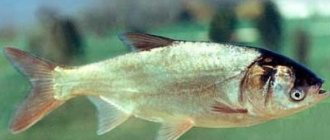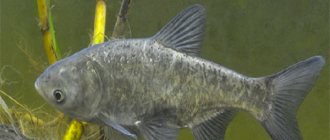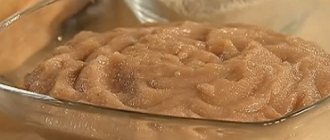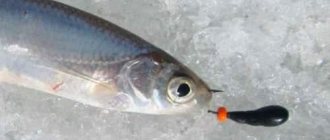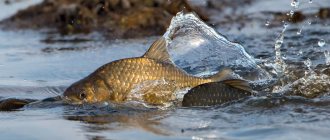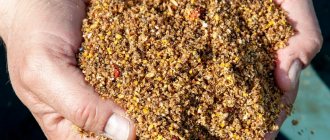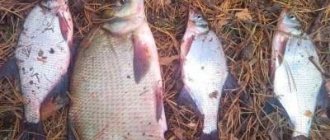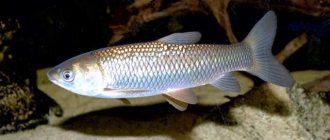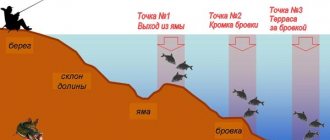Requirements for baits
When choosing bait, you should take into account the fact that this fish is a herbivore. Its mouth is positioned to collect plankton from the bottom. This distinguishes it from many other fish. The bait should be sinking and form a slight haze around itself.
Before fishing you need to use bait. Without it, it is unlikely that you will be able to attract the attention of this fish. In addition to the bait itself, a small foam ball is put on the hook so that it does not sink to the bottom, but stays above its surface. There are many ingredients that have a chance of catching silver carp, so it is advisable to have several types of them with you: canned corn, boiled peas, pieces of mushrooms, vegetables or berries. If it is bread, it should be soft and have a crust.
Tackle
When preparing to catch silver carp, special attention should be paid to gear. You can use special carp sticks, hooks or a feeder.
If you plan to fish on the surface, then a tackle with a spring is best suited. It has a large load capacity. Just below the float there is a feeder or spring, above it there are hooks.
You can also use a water ball and invisible fishing line. This type of tackle is ideal for surface fishing.
On the donk

Tackle for bottom fishing does not have a particularly complex structure. As a rule, a strong fishing rod is used, because silver carp is a strong fish and the angler’s task is to pull it out. The main component of such tackle is the sinker.
First, a tube-shaped outlet is installed on a strong fishing line, a feeder is attached to this outlet, a bead is attached on top of the feeder, and then a swivel is attached. There are usually at least three leashes installed on such tackle.
The place where you intend to fish must be fed. For this type of fishing, it is best to use geyser food. It floats to the surface and does not form turbidity, but a cloud on the water that attracts silver carp.
Catching silver carp with a float rod is not at all difficult. Most often this is an ordinary “carp” stick. The only difficulty is choosing a float.
If the surface of the reservoir is replete with sticks, leaves, reeds, etc. floating on it, then it is better not to choose a float with an “antenna”. The fish may be surprised by the fact that everything is floating, but the antenna is in a vertical position.
Since silver carp is a cautious fish, it may not show interest in the bait, so it is better to choose a float that will be positioned horizontally.
Basically, two types of floats are used for float fishing:
- Extended foam float in the shape of a spindle. The lower part is studded with pellets for weight, and the top is painted in a bright color.
- The float is of the usual round shape , with a barely noticeable “antenna”. It should be positioned so that it is horizontal on the water.
The best natural baits and lures for silver carp
This fish is excellently caught where the water is slightly cloudy. Therefore, the best baits will be those that are able to create a similar effect around themselves. Many fishermen use natural baits:
- Green peas - several pieces are placed on the hook, completely covering its sting.
- Canned corn – used in the same way as peas.
- Vegetable pieces - cut into small pieces. Cabbage leaves are good for this.
- Various porridges - mainly semolina and millet porridge.
- Bread should be soft, with an elastic crust. A hook is threaded through it twice.
- Young shoots of reeds - they can often be found near any body of water. The bait most often used is one that contains algae.
Ready-made baits for catching silver carp
Specialized stores often sell high-quality baits. One of them is ready-made technoplankton. It is a pressed food powder that easily dissolves in water and forms a slight cloudiness. It contains aromatic and flavoring substances. There are several different types of technoplankton: anise, honey, strawberries, bloodworms, blood, vanilla, raspberries. Looks like a small barrel. Suitable for fishing with a bottom fishing rod.
If you want to learn how to make technoplankton with your own hands, you can learn about it from our article.
In addition, silver carp are often caught using foam balls, which are placed on hooks of 2–3 pieces. Sometimes it is possible to catch it on an empty hook, having previously wrapped it in algae.
How to choose bait depending on the season
The activity of fish always depends on the time of year. Therefore, the baits chosen for each pore are different.
In winter, you should catch silver carp when there is a thaw or after the first ice appears. Hooks are available in 4 sizes. The best baits for them are bloodworms and jigs. You can use scented baits and corn. Before fishing, you should feed the fish for at least two days. A small hole is made in the ice and plant bait is poured into it. Choose a fairly strong fishing rod with a thick fishing line. When fishing, the bait should be at the very bottom.
When spring comes, silver carp feeds on detritus (the top layer of silt). Unlike in winter, the nozzle is placed 10 cm from the bottom. The ideal bait at this time is polystyrene foam or small pieces of foam rubber. They have no smell, so they are not able to scare away fish.
The best time to hunt silver carp is summer. At this time there is a lot of natural organic food and he practically does not pay attention to artificial baits. The best time of day to catch him is morning. In summer, he chooses places where there is a lot of vegetation for his parking. You can use insects, cereals, technoplankton, pieces of vegetables and mushrooms as bait.
In autumn, its activity decreases significantly. Silver carp can be found at this time in those sections of rivers where the current is weak, especially in shallow water. There he looks for the remains of vegetation. It is good to catch bait from porridge and technoplankton tablets. For fishing, use a float rod, donka and feeder.
When to catch silver carp
Silver carp is a very heat-loving fish and therefore it begins to actively feed when the water warms up to a temperature of about 18-20 ° C, this is approximately mid-May, the exact period when silver carp begins to be active depends on the region and weather conditions. He also stops pecking early - in September he already stops being caught. In winter, silver carp are not caught.
But silver carp are actively caught all summer. The best biting time is morning and evening; at night, silver carp bites occur very rarely. It should be taken into account that during the day, silver carp goes far into the depths of the reservoir, and in the morning and evening it comes closer to the shore, but still keeps a decent distance from it and is unlikely to come closer than 20-30 meters.
If the reservoir is a small reservoir, you can simply bring the gear to the middle of the reservoir, and if it is a large reservoir, it would be more advisable to bring the bait further away during the day, and move it closer to the shore in the morning and evening.
The porridge or technoplankton should be replaced approximately every couple of hours. True, technoplankton may be of poor quality and will not dissolve at all in 2 hours; naturally, such technoplankton will not create turbidity and will not attract silver carp.
At night, so that your gear doesn’t sit idle in vain, you can switch it to carp fishing. And when morning comes, preferably after dawn, set up the silver carp killer again. At dawn, the probability of catching carp is higher than silver carp, since silver carp wakes up more slowly and dawn is not the optimal time for catching it, but carp can be very active at this time of day.
Also check out a very interesting and useful article about catching silver carp from the bottom.
A few facts about silver carp
Silver carp do not spawn in ponds where they are artificially introduced. For spawning, silver carp requires a water temperature of about 30° and at the same time it must be flowing. Naturally, such conditions cannot be created at headquarters.
The natural habitat of silver carp, where it has all the conditions for reproduction, is the Amur River. It was also artificially transferred and successfully took root in some other warm rivers.
There are two types of silver carp - white and motley . These species differ in color and size. The silver carp is a larger representative and can grow 2 times larger than the bighead, reaching a weight of up to 70 kg.
Even when you catch silver carp for the first time, the probability of a catch in a reservoir stocked with silver carp is very high, especially if you fish with several gears at the same time.
DIY bait recipes
It is not necessary to buy bait in the store; you can make it yourself from ingredients that can be found in every home. Various cereals and technoplankton prepared at home are popular.
To prepare the bait you will need:
- Millet – 3 kg.
- Makukha – 1 glass.
- Breadcrumbs 2 packs.
- Powdered milk – 150 gr.
You can add 250 grams of store-bought bait.
Millet is pre-divided into two parts of 2 and 1 kg. The first part should be boiled for about 15 minutes. You need to make sure that the mixture does not burn, but also avoid frequent stirring. Grind the smaller one. Leave the boiled porridge wrapped in a towel for 3 hours. Add the remaining products before fishing, mix thoroughly.
- 4 liter saucepan.
- Peas – 1 kg.
- Semolina – 2.5 kg.
- Honey – 1 tbsp. l.
Water is poured into the container and brought to a boil. Peas are poured into it, after which the gas on the burner is reduced to a minimum. Cook the porridge for approximately 4 hours. The porridge should be stirred periodically to prevent it from burning, otherwise you will have to cook it again. When the peas are ready, they should be passed through a colander. The strained broth is put back on the fire, and the peas are set aside for bait on other fish.
Pour semolina into the broth, stirring it with a spoon to avoid the appearance of lumps.
When the porridge is ready, it needs to be removed from the heat and kneaded until it stops sticking to your hands. After this, honey is added and everything is put in the refrigerator.
Technoplankton can be prepared in a similar way. There are several recipes for its preparation:
- Semolina – 500 gr.
- Corn flour – 500 gr.
- Breadcrumbs – 300 gr.
- Mamalyga – 300 gr.
- Sugar – 300 gr.
All products are mixed in a large container, and water (a small portion) with honey is added.
- Condensed milk – 1 can.
- Cake powder.
- Powdered milk.
Condensed milk is poured into a bowl and beaten with a mixer. Gradually milk and cake (half the portion) are poured in there.
You need to mix until you get a mass with the consistency of sour cream. After this, the mixture is placed in the refrigerator for 40 minutes. After removing the mass from the refrigerator, it is diluted with the rest of the milk powder and cake, adding a little water.
First stage.
- Dog food – 500 gr.
- Roasted crushed peanuts – 100 gr.
- Sweet paprika (powder) – 50 gr.
- Powdered sugar – 200 gr.
Mix all ingredients in the first bowl.
Stage two. Take another container and place the following ingredients in it:
- Boiled potatoes – 500 gr.
- Bananas – 1 kg.
- Egg yolk.
- Condensed milk – 50 mg.
Mash everything and mix with the first part to form a dough. This mass can be rolled into barrel shapes. Used as groundbait and also as bait.
Blitz tips
- Silver carp is a shy fish. During fishing, complete silence and camouflage must be observed.
- The fishing line is chosen to be at least 0.25 mm.
- When fishing, it’s a good idea to have a hook with you. You have to be very careful when pulling out the fish, because it offers quite strong resistance.
- It often happens that the current interferes with successful fishing. The bait is carried away from the place where it was thrown. To avoid this, put on a sliding weight weighing about 100 grams. depending on the capabilities of the rod. When the weather is calm, you can remove the sliding weight from the rig, replacing it with a regular one. In this case, a large float is installed that can withstand up to 50 degrees. loads.
- Successful fishing is carried out the same way both with a donk and a float. The advantage of the latter is the possibility of fishing at different depths. Also, when floating, it is important to use two baits - heavy and light. The first creates cloudiness in the water, the second is used as an additional one.
Description and behavior characteristics
Silver carp is a commercially valuable fish. It is found in schools mainly in fresh waters, preferring to feed on phytoplankton and algae. It is difficult to confuse an aquatic inhabitant with other inhabitants due to some features in appearance and behavioral habits.
In silver carp:
- silver body;
- big head;
- high forehead;
- small eyes located slightly below the mouth.
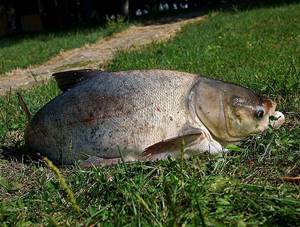
By species, hybrid, bigheaded and silver carp are distinguished:
- Whites prefer to live in muddy greenish water, constantly cleaning it of detritus and feeding on phytoplankton.
- Variegated individuals feed on zooplankton and river vegetation. They live up to 20 years, reaching 1 meter in length.
- Hybrids , bred by breeders, are considered the most common type of commercial fish. They are distinguished by the presence of a large head covering almost half of their body and feed on zooplankton. They go to spawn late (closer to July), when the water temperature is no lower than +20°C. Hybrid silver carp are voracious and are considered caretakers of overgrown reservoirs, because in short periods of time they can destroy all algae, thereby improving lakes and reservoirs. Average weight is 4-5 kg upon reaching 4 years of age.
Fish are rarely seen on the surface of the water. When the temperature drops below +8°C, it goes into the depths of the water and the bite stops. Although you can often see splashes on the water when the fish jumps out of the water, making loud sounds.
In winter, silver carp goes into sleep, preferring deep holes in the reservoir. Thanks to reclamation features, heat-loving silver carp have now acclimatized to our Russian conditions. They are found in the waters of different regions of the country, growing up to 2 meters in length and weighing up to 0.5 centners, eating all kinds of algae in large quantities.
In some places in Russia the climate is quite harsh and fish are not capable of reproduction. This is of particular interest to experienced fishermen. Catching a large specimen is a success, although one weighing 3-4 kg can be caught quite well.
